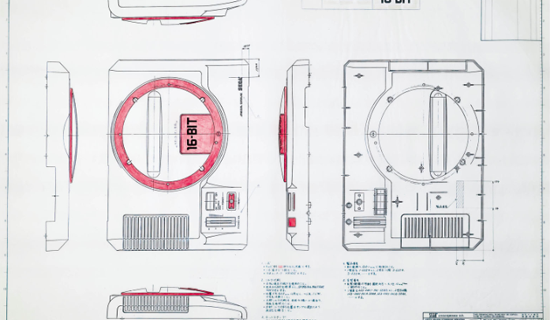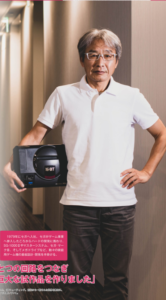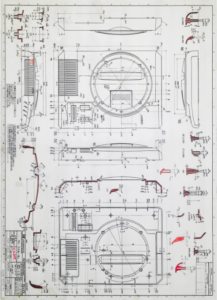Masami Ishikawa (Former Member of the Sega Interactive Product R&D Division)
He joined Sega in 1979. From the time Sega entered the home console market, he planned out designs for the SG-1000 II, Master System/Sega Mark III, Mega Drive, and other pieces of hardware.
The Mega Drive was released in 1988 with the slogan “The 16-bits that the era demands” (in Japan). Today we’re talking to Masami Ishikawa about the hardships he went through when planning for the development of this console that was so powerful for its time.
Two Straight Years of Suffering in Circuit Board Design
You were given the responsibility of developing the Mega Drive hardware, Mr. Ishikawa, but what were your actual feelings about that at the time?
(Ishikawa) Honestly, I didn’t have confidence that I would be able to do it (Laughs). I was involved in the development of the Mega Drive from the time Mr. Sato (Hideki Sato) asked “We have the new parts, will you try making it?”. The Mega Drive had two CPUs (one main and one sub) and RAM specifically for video, since it was a company directive to make it close to the graphical fidelity of the high performing System 16 board that was in arcades at that time. I really agonized over the best way to use the parts to create a high performing home console.
Incidentally, how long did the development process take from beginning to end?
(Ishikawa) Up until now I’ve always answered “a year and a half” to that question, but recently I’ve reevaluated that. It seems more like it took about two years to develop. I think that was a pretty long development cycle for the time. Although with development environments at the time, everything from diagrams to specification documents was all done by hand….I think that nowadays you’d be able to finish something like much more quickly.
What was the hardware development process like?
(Ishikawa) I made it so that all aspects of the video output in the Mega Drive were handled by a full custom IC, manufactured by Yamaha. The test board was the first ever time it was used. The size of it was smaller during manufacturing, but during the design stages I had to make a large prototype roughly the size of several tatami mats, in order to verify that the processor was working. I had to connect every single circuit by hand (Laughs)
That sounds really rough…
(Ishikawa) Making the prototype itself took a month. And when the prototype was completed, with the CPU and memory connected, I debugged the board layout. A processor is a part that does a lot of different kinds of data management, so it’s necessary to increase the speed to make it perform an appropriate amount of operations. For example: Character A is displayed on the screen, and at the same time you have to prepare screen B, then produce a sound effect. To make a computer do all those things, the processor managing the video output has to send the appropriate instructions. And in order for the CPU and memory to be able to transmit information at the same time, it was necessary to create a road on which there would be no traffic jams, so to speak.
So once that processor was completed, did things go smoothly from there?
(Ishikawa) The position of all of the components on a board impacts the processing speed, so I had to think about the best arrangement for all of them as well (Laughs). Processing speed has a big impact on performance when it comes to game consoles.
I see. By the way, were you also responsible for the design of the Mega Drive’s casing?
(Ishikawa) No, a different department handled that.
So was the case design determined after the size of the board you designed was?
(Ishikawa) No, the design came first. The size of the case and such was decided beforehand, and I had to design the board to somehow fit within it. The part where you insert the cartridge had already been completed, so I first had to make it so that you could insert the cartridge there. And as the layout progressed, I had to be more and more careful to keep in mind the position of that area. It was really difficult.
Incidentally, the Mega Drive has a lot of expansion ports to accommodate a lot of peripherals, but were all those assumptions from the design stage?
(Ishikawa) I’m not completely certain whether or not Mr. Sato had planned for that initially or not. But from my perspective, I just had to make sure that there were ports that could handle all of these peripherals if they were made available and connected to the unit. I wasn’t involved with the Mega CD and such, but that made me glad that I had made sure that the system had plenty of expansion ports.
How did you feel once you’d finally completed development of the Mega Drive?
(Ishikawa) Honestly I felt more like “I’m finally done!” than I felt a sense of accomplishment (Laughs bitterly). The first time I felt a sense of accomplishment after that product went on sale was when the Genesis hit it big in the west, and I heard that we had beaten Nintendo.
What did you work on after the Mega Drive went on sale?
(Ishikawa) I moved over to the division that handles development of arcade game hardware. The team developing arcade games that I transferred to had begun grappling with development of next generation hardware, but the team that was working on what would become the Sega Saturn had already been formed by the time the Mega Drive was in mass production.
The Mega Drive Mini That the Fans Want
About when does crunch time set in for hardware development?
(Ishikawa) It’s quite a bit different for hardware than it is for software, you don’t have to go right up to the last minute in order to make delivery. For hardware, it’s mostly all in the initial phase of development. When you’re making a board for testing, bugs can be discovered that wouldn’t have been found during debugging. And when that happens…it’s staring at the board and layout diagrams with bloodshot eyes to try to find the problem. Because when there’s a bug in the hardware, it’s lethal. And with hardware, tracking down those bugs really takes a lot of time. Once you find the part that’s causing the problem, you cut the connection to the circuit that’s causing the bug using a laser, on the wafer inside of the integrated circuit. Then you use an ion beam to make a new electrical connection and repair the correct circuit to get it working again…That’s the kind of work you do to fix bugs in hardware.
Now that you mention it, a hardware bug really would be fatal.
(Ishikawa) That’s right. Home consoles are pieces of hardware that are played for many years after the fact. Having a bug exist in that same hardware would make it all amount to nothing. That’s why hardware is so carefully debugged.
Where there any particular bugs that you can remember finding during the development of the Mega Drive?
(Ishikawa) No, there were no bugs that impacted functionality. It was said that historically the colors produced on Sega’s hardware tended to bleed on screen. It was the same for the Mega Drive, but it was identified before we entered mass production. In thinking about how to prevent that, I put a smaller circuit board on top of the main board, and that was able to prevent it to a certain extent. At some point there was a minor change to the hardware, and things were reworked to move that functionality onto a chip, and so the additional board was removed.
Down to that level of detail…Also, did you play any of the Mega Drive games at that time?
(Ishikawa) Yeah, I played them a little bit. I was bad at action games, so I played a lot of shooting games instead. I really liked Super Fantasy Zone and Space Harrier II a lot. I also loved puzzle games, so I think I played a lot of Puyo Puyo and such as well. Thinking about it now, I may have liked the games that I was able to play for a bit during periods of free time.
The Mega Drive Mini is planned to go on sale next year. But as the developer of the original, what do you think about that?
(Ishikawa) I’m actually very happy about it. I’d like for all of the old fans of the system to get one so that they can feel that nostalgia for it. I really struggled back then to get the board down to that small of a size, but these days you can get it down to a size that fits in the palm of your hand. That really makes me realize just how much times have changed (Laughs)


